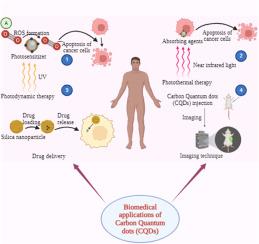Biomedical application of carbon quantum dots: A review
IF 3.1
Q2 MATERIALS SCIENCE, MULTIDISCIPLINARY
引用次数: 0
Abstract
The many beneficial properties of carbon quantum dots (CQDs) have led to their increased interest as a potential material for use in various biomedical applications. These properties include fluorescence, biocompatibility, low toxicity, small size, ease of modification, low production costs when scaled up, and versatile conjugation with other nanoparticles. In addition, the development of theranostic nanomedicine, bio-imaging of cells and bacteria, and multifunctional diagnostic platforms have all shown promise. Optical imaging, cancer therapy, drug delivery systems, gene delivery, antimicrobial activity, bioimaging and biosensors, photothermal and photodynamic therapy, pharmaceutical formulations, and more are all parts of CQD research that this review succinctly summarises. The literature primarily describes two approaches for synthesizing CQDs: the top-down approach, which involves disassembling a larger carbon structure into nanoscale particles, and the bottom-up approach, which involves creating CQDs from smaller carbon units (small organic molecules). The literature has a large number of review articles about the synthesis and uses of CQDs. Nevertheless, there isn't a comprehensive paper like this that goes over the entire process of creating and using CQDs made of tiny organic compounds. Based on the available literature, we have compiled the research progress on CQDs in this review, including its synthesis from small organic molecules (bottom-up approach), applications in the fields of bioimaging, drug/gene delivery systems, photocatalytic reactions, photodynamic therapy (PDT), and photothermal (PTT) therapy, as well as methods of thermal decomposition and microwave irradiation and ultrasonic treatment. Lastly, the difficulties and potential course of CQDs are explored. Our conversation also broadens to cover CQDs function in nanomedicine, the field that many believe will shape biomedicine in the years to come. The results of this study will help the biomedical research community realise the potential of CQDs to solve many present-day technological issues.

碳量子点的生物医学应用:综述
碳量子点(CQDs)具有许多有益的特性,因此作为一种可用于各种生物医学应用的潜在材料,人们对它的兴趣与日俱增。这些特性包括荧光、生物相容性、低毒性、体积小、易于改性、放大生产成本低,以及与其他纳米粒子的多功能共轭。此外,治疗用纳米药物、细胞和细菌的生物成像以及多功能诊断平台的开发都大有可为。光学成像、癌症治疗、给药系统、基因递送、抗菌活性、生物成像和生物传感器、光热和光动力疗法、药物制剂等都是 CQD 研究的内容,本综述对此进行了简明扼要的总结。文献主要介绍了合成 CQD 的两种方法:一种是自上而下的方法,即把较大的碳结构分解成纳米级颗粒;另一种是自下而上的方法,即从较小的碳单元(小的有机分子)生成 CQD。文献中有大量关于 CQDs 合成和用途的综述文章。然而,还没有一篇像这样的综合性论文来介绍用微小有机化合物制造和使用 CQDs 的整个过程。在现有文献的基础上,我们在这篇综述中梳理了 CQDs 的研究进展,包括其从小有机分子的合成(自下而上的方法),在生物成像、药物/基因输送系统、光催化反应、光动力疗法(PDT)和光热疗法(PTT)等领域的应用,以及热分解、微波辐照和超声波处理的方法。最后,我们还探讨了 CQDs 的难点和潜在发展方向。我们的话题还扩展到 CQDs 在纳米医学中的功能,许多人认为这一领域将在未来数年内塑造生物医学。这项研究的结果将有助于生物医学研究界认识到 CQDs 在解决当今许多技术问题方面的潜力。
本文章由计算机程序翻译,如有差异,请以英文原文为准。
求助全文
约1分钟内获得全文
求助全文
来源期刊

Carbon Trends
Materials Science-Materials Science (miscellaneous)
CiteScore
4.60
自引率
0.00%
发文量
88
审稿时长
77 days
 求助内容:
求助内容: 应助结果提醒方式:
应助结果提醒方式:


